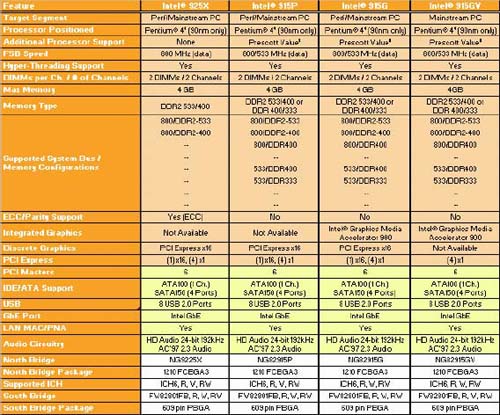Intel 925X/915: Chipset Performance & DDR2
by Wesley Fink on June 19, 2004 3:01 AM EST- Posted in
- CPUs
Chipset Feature Comparison
With all of the new chipset options and features, a scorecard might help to understand the new 925X/915 chipsets and supported options.| 1 Adaptive Synchronization aligns to the closest FSB to memory clock ratio, setting memory channel to 320 MHz. 2 Does not support Pentium® 4 or Celeron® processors with a .18µ core. 3 ICH5R support Intel® RAID. 4 Supports only Pentium® 4 processors based on 90nm manufacturing technology 5 Hyper-Threading Technology support starting with B-step. 6 DDR 333 support starting with Bstep. |
If you look closely at the features, you will see that Intel High-Definition audio is available on all the new chipsets, even the value-oriented 915GV. This is only part of the story, however, since the Southbridge must be combined with an audio codec that supports all the High-Definition features. You will need to look closely at the motherboard specifications to see what audio features are actually supported by the motherboard manufacturer.
Intel's commitment to Gigabit LAN is also apparent in the across-the-board support for Gigabit LAN on the new 775 chipsets. PCI Express x16 is the only Graphics Slot supported. 4 SATA ports and one IDE channel are available on all the new 775 chipsets.
Much good and bad has been reported about Intel's use of DDR2 with the new 925X/915 chipset. Intel is apparently hedging their bets on DDR2, since you will see that DDR2 is only required for the top-end 925X. All of the 915 chipsets can support either DDR or DDR2, depending on what the motherboard manufacturer chooses to support. There are even a few dual-memory socket 775 boards, like the Gigabyte that we use later in the review to compare the performance of DDR and DDR2 memory. Intel is clearly supporting DDR2 on the Intel 915 board that we are testing, but most 3rd party manufacturers appear to be supporting DDR on their 915 motherboards.











57 Comments
View All Comments
nserra - Tuesday, June 22, 2004 - link
You guys are only evaluating the performance, I think it's not that important, the features yes, those are important. The P4 is crap even with hyper-x,y,z, so it wasn't a "chipset" that was going to make a miracle.I would like to see the new platform tested, IGP, Sound system, EMT64 (is it enable on LGA775 processors?), NX bit?, new power saving techniques, so new features up to test.
At least the DDR vs DDR2 comparison is a good thing.
I was hopping that DD2 would give a performance boast, since the P4 architecture relies on higher bandwidth and higher latency (the pros of RDRAM i850), but I guess not....
Bozo Galora - Monday, June 21, 2004 - link
yes he's sureRyanVM - Monday, June 21, 2004 - link
#54, Are you sure you aren't thinking of the S754/S939 dual socket mobo?tfranzese - Sunday, June 20, 2004 - link
#53, yes, there's a board that was shown at Computex that had both sockets giving the option to use one or the other.RyanVM - Sunday, June 20, 2004 - link
So, any chance that the 915 chipset can be tied to a socket 478 + Northwood? :DMarlin1975 - Sunday, June 20, 2004 - link
AMD does not really need dual ch. memory. Look at the diff. between a socket 939 and 754, it is very little for most apps. Also Dual Ch memory is not new. It was used WAY back in the day.The only reason it is back is because intel can't design a decent CPU so they have to make up for it with pricey and unneeded tech.
tfranzese - Sunday, June 20, 2004 - link
Anemone, there's really little reason you need dual-channel memory on the AMD64 platform with the memory controller being on the chip.Anemone - Sunday, June 20, 2004 - link
Anti overclocking designs in the new chipsets? Very poor choice.I will reiterate Intel performance per $ over its previous generations is pathetic. More $ required per degree of performance and the increase over last year is poor.
AMD is expensive until you get to the 754 - but perhaps I'm mistaken but I thought the industry had left single channel memory configurations behind 2 years ago. Oh wait, it's AMD, that's about their catchup period, sorry. So yes look at AMD in dual channel AMD64 chips and yes they are very pricey. So much for their argument that by providing competition they keep prices down.
Add to all that the overclocking unfriendly stuff, and while AMD comes out as better overall, the performance per $ is still not markedly better than last year, imo.
:)
Bozo Galora - Sunday, June 20, 2004 - link
"My My We are in trouble now arent we..."Yeah, I guess we might have to offer AMD a few of our (cash in the bank) billions to buy them out. I wonder if the FTC will allow that? Hmmmmm. Let's investigate.
firtol88 - Saturday, June 19, 2004 - link
My My we are in trouble now aren't we...Looks like AMD is the clear choice, unless you need a heater.